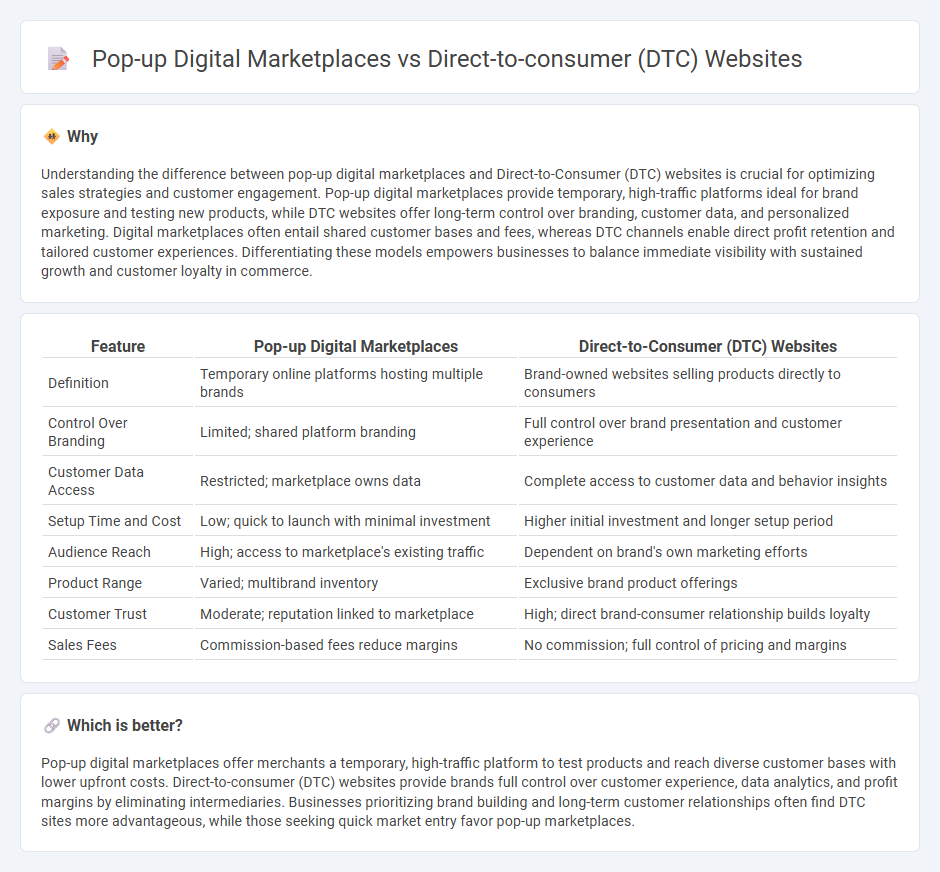
Pop-up digital marketplaces offer brands temporary, high-visibility platforms to reach niche audiences without long-term commitments, leveraging aggregated traffic and curated shopping experiences. Direct-to-consumer (DTC) websites enable brands to cultivate direct relationships with customers, collecting valuable data and controlling the entire purchase journey for increased profitability. Explore the advantages and strategies behind pop-up digital marketplaces and DTC websites to optimize your e-commerce growth.
Why it is important
Understanding the difference between pop-up digital marketplaces and Direct-to-Consumer (DTC) websites is crucial for optimizing sales strategies and customer engagement. Pop-up digital marketplaces provide temporary, high-traffic platforms ideal for brand exposure and testing new products, while DTC websites offer long-term control over branding, customer data, and personalized marketing. Digital marketplaces often entail shared customer bases and fees, whereas DTC channels enable direct profit retention and tailored customer experiences. Differentiating these models empowers businesses to balance immediate visibility with sustained growth and customer loyalty in commerce.
Comparison Table
| Feature | Pop-up Digital Marketplaces | Direct-to-Consumer (DTC) Websites |
|---|---|---|
| Definition | Temporary online platforms hosting multiple brands | Brand-owned websites selling products directly to consumers |
| Control Over Branding | Limited; shared platform branding | Full control over brand presentation and customer experience |
| Customer Data Access | Restricted; marketplace owns data | Complete access to customer data and behavior insights |
| Setup Time and Cost | Low; quick to launch with minimal investment | Higher initial investment and longer setup period |
| Audience Reach | High; access to marketplace's existing traffic | Dependent on brand's own marketing efforts |
| Product Range | Varied; multibrand inventory | Exclusive brand product offerings |
| Customer Trust | Moderate; reputation linked to marketplace | High; direct brand-consumer relationship builds loyalty |
| Sales Fees | Commission-based fees reduce margins | No commission; full control of pricing and margins |
Which is better?
Pop-up digital marketplaces offer merchants a temporary, high-traffic platform to test products and reach diverse customer bases with lower upfront costs. Direct-to-consumer (DTC) websites provide brands full control over customer experience, data analytics, and profit margins by eliminating intermediaries. Businesses prioritizing brand building and long-term customer relationships often find DTC sites more advantageous, while those seeking quick market entry favor pop-up marketplaces.
Connection
Pop-up digital marketplaces and Direct-to-consumer (DTC) websites both streamline the buying process by directly connecting brands with consumers, eliminating traditional retail intermediaries. Pop-up digital marketplaces offer limited-time sales events that boost brand exposure and create urgency, complementing the ongoing engagement and personalized customer experience found on DTC websites. Together, these platforms empower brands to test markets, gather consumer data, and increase sales efficiency through targeted digital strategies.
Key Terms
Customer Acquisition
Direct-to-consumer (DTC) websites enable brands to build direct relationships with customers, optimize data collection, and control branding for efficient customer acquisition. Pop-up digital marketplaces offer brands immediate access to diverse customer bases and lower upfront costs but often lack deep customer insight and brand control. Explore more to understand which strategy best accelerates your customer acquisition goals.
Brand Control
Direct-to-consumer (DTC) websites offer brands full control over their customer experience, from website design to data collection and personalized marketing strategies. Pop-up digital marketplaces, while providing quick access to a broad audience, often limit brand control due to standardized platform rules and shared customer data. Explore detailed comparisons to understand which approach maximizes your brand's control and growth potential.
Platform Fees
Direct-to-consumer (DTC) websites usually offer lower platform fees compared to pop-up digital marketplaces, enabling brands to retain higher profit margins by avoiding commission cuts typical on marketplaces like Amazon or Etsy. Pop-up marketplaces often charge fees ranging from 5% to 20% per transaction, which can significantly reduce net revenue for sellers, but they provide broader audience reach and marketing support. Explore detailed fee structures and strategic benefits of both options to optimize your e-commerce platform selection.
Source and External Links
The Rise of Direct-to-Consumer (DTC) Brands | Creative 7 Designs - This source explains the DTC model where brands sell directly to customers via their own websites, bypassing wholesalers and retailers, allowing better customer relationships and control over the sales process, with examples like Warby Parker and Glossier.
21 Top Direct-to-Consumer Brands Acing Customer Experience - Describes DTC brands as ecommerce businesses selling directly from warehouses without middlemen, enabling closer customer relationships and more control over the shopping experience, and highlights top examples and trends.
40 Direct-to-Consumer Brands To Explore (2025) - Shopify - Lists leading DTC brands across industries, detailing their unique approaches to online selling, marketing, and customer engagement, including brands like Casper, Glossier, Away, and Everlane.
 dowidth.com
dowidth.com